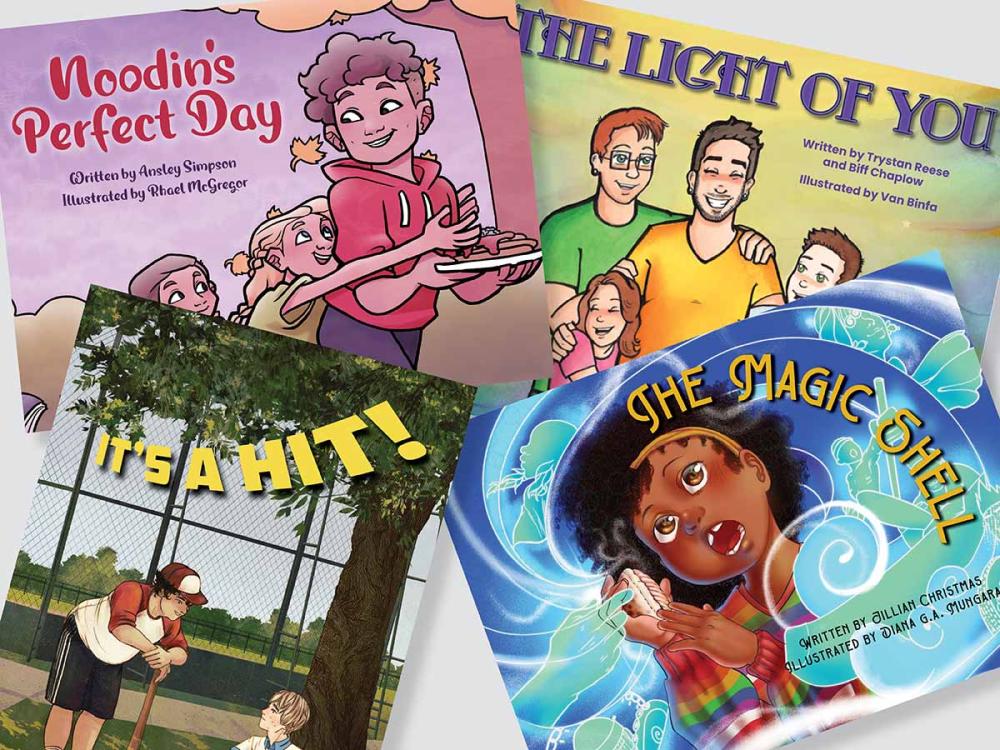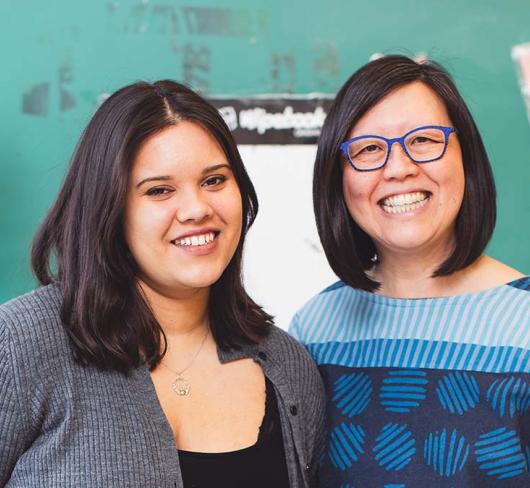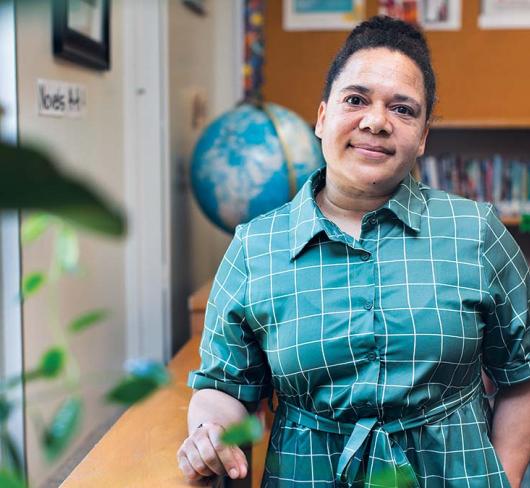
Flamingo Rampant
For most of my 21 years as an elementary educator, I’ve worked as a teacher-librarian. One of the delights of my role is selecting new materials to share with colleagues and students. One of the challenges is finding books that reflect the diversity of the children I teach and their families. A lot of fiction titles promoted as “diverse” are focused on a singular issue be it gender, sexuality or ethnicity. Such books, even in the realm of fiction, tend to lean hard on explaining a group of people, rather than letting them live inside their stories.
And so, I have been delighted these last few years by the emergence of a micropress, Flamingo Rampant, now in its fifth season. According to their website, Flamingo Rampant publishes “fun stories and beautifully illustrated children's picture books containing important values like racial justice, disability pride, kids taking action and, most of all loving, positive 2SLGBTQ+ families and communities.” For each new series of books, Flamingo Rampant solicits start-up funds via KickStarter, which also allows supporters to pre-order titles. Until now, the publisher has focused on picture books, but this new season’s offering includes two novels for readers in the junior to intermediate grades, which I’ll discuss later.
In Noodin’s Perfect Day, Noodin (meaning wind in Ojibwe) awakes with the perfect plan for the day at the house they share with their mom, a plan which includes pancakes and dogs to pet. “But the BEST part about Noodin’s PERFECT day is that the last THREE chapters of their book will be read, lying on the grass, under their FAVOURITE shady tree.” Of course, the day does not go according to plan, as Noodin’s mom tells them she has an online language class. Further complications arise when Noodin’s Aunty drops off her two young children for them to care for while she’s at the dentist. With cousins in tow, Noodin tries to salvage their plan by visiting their father, who has also been suddenly called in to work from home. With the help of their cousins, Aa and B, Noodin ends up having a somewhat different day than hoped for, but one that is quite satisfying nonetheless.
This title lends itself to rich discussions with young readers who may notice that Noodin is described in the third person by they/them pronouns. By now, many Primary learners are becoming familiar with inclusive pronoun usage, as well as nonbinary and trans identities. Similarly, the use of some familiar Indigenous language, such as miigwech, may prompt readers to infer that their family is First Nations. Many readers will relate to the predicament of having parents called away to work – while still at home – in an era of social distancing and video conferencing.
The Magic Shell takes a youngster on a journey of discovery about her ancestors. Pigeon Pea waits restlessly as her parents, her aunty and her aunty’s sweetheart prepare a feast for the family. She peppers her aunty with questions, “Like who is my grandma’s grandma, and where did she live and play? And if she was here with us right now, what do you think she would say?” Aunty gives Pigeon Pea a cowrie shell, which she promises “carries the stories of our people across seas and distant lands, and if you listen very close and hold it very near, there’s a magic inside this little shell that might just take you there.”
With that, Pigeon Pea is off to meet her great-great-great-grandmother in Tobago and then on to West Africa. Throughout her adventure, Pigeon Pea is reminded that she carries her ancestors with her: “We are always rooting for you! We are with you wherever you are. So, if you’re ever feeling lonely, you can call on your family; we are never far.”
Jillian Christmas’ verse is beautifully accompanied by the warm, dream-like illustrations of Diana G.A. Mungaray. Young readers will speculate as to whether Pigeon Pea actually takes this journey in the story or if it is her imagination at work; they will likely find either interpretation satisfactory. As with Noodin’s Perfect Day, this title includes a brief glossary of words used in the text; however, many students and teachers should be able to assemble meaning from context. Like other Flamingo Rampant books, queer characters are part of the narrative; they exist without explanation or justification. And so, it is especially satisfying that Aunty, whose “sweetheart” is called June, is the elder and trusted adult who sets Pigeon Pea on her journey.
This matter-of-fact presence of queerness is central to The Light of You by Trystan Reese and Biff Chaplow. A cover illustration with two dads and a couple of kiddos is no longer unusual in children’s literature, but this may well be the first picture book published in which one of the dads is pregnant. The Light of You, with the help of illustrator Van Binfa, is part picture book, part scrapbook. The story is narrated by a transgender dad, speaking to his newborn child of all the preparations leading up to their birth.
Dad recalls a gathering of loving chosen family, reassuring an older sib anxious about change, and even being cared for by the other parent Dada when he felt sick during pregnancy. Space is left in the book for young readers to add their own pictures and words to talk about “who welcomed them as a small person,” or “who gives them hugs,” and “who shares laughter with them.” While this picture book breaks new ground, I think most young readers will find it highly relatable because it centres the excitement of greeting a new family member. Additionally, a title that depicts fathers as the curators of loving home environments is always welcome.
Portraying men and boys as caring and safe people is core to one of Flamingo Rampant’s first two novels for intermediate readers, It’s A Hit! Arin Cole Barth’s and Marika Barth’s story is set in a summer baseball camp and finds Taylor and Wil randomly matched up as roommates who form a deep bond of friendship during their three-week stay. Readers will anticipate an apparent mismatch of characters, but there’s more to the story, and I’ll get to that.
Young Sluggers Baseball Camp is Taylor’s second home. He’s popular with his friends there – most of whom he doesn’t get to see outside of camp – and he’s a gifted starting pitcher. The son of two politically active queer moms, he’s thoughtful about asking for and sharing pronouns, and he is very informed about consent and boundaries. He seems like a kid who has it all together.
Wil, who would rather be at his beloved theatre camp, is more reluctant about the summer ahead. Having recently begun to live as a boy, he acquiesced to his father’s well-intended, if ill-informed, effort to validate his son’s identity. Wil isn’t just worried about being accepted as a boy; he’s downright terrified of what will happen when fellow campers discover that he’s never played baseball. Predictably perhaps, Taylor volunteers to coach his roommate; however, the relationship between the pair is not one-sided, and we see both boys grow from it.
Rather than conventional chapters, the book is divided into four main parts, or acts. What is unique and essential to the structure is that the three-week narrative is disclosed alternately from Wil’s and Taylor’s points of view every two or three pages. While the reader has a strong sense of Wil’s vulnerabilities from the beginning, Taylor has his own worries that aren’t immediately perceptible. Over time, as the pair share more with each other, a deep friendship unfolds. Along the way, readers have the opportunity to ponder a variety of themes, including fatphobia, racial stereotyping, neurodivergence as well as trans and non-binary identities.
It’s A Hit! is a refreshing take on sports-themed novels. Where other titles in this genre focus on leadership, Wil’s and Taylor’s story is one of collaboration. As the participation of trans kids in athletic competition has sparked ugly responses in some jurisdictions, it’s a relief to read a story in which queer and trans kids and their families are made to feel welcome at a sports camp. A book in which male characters freely dispense affection and caring should be a welcome addition to any diverse library.
Readers who love adventure will revel in Chy Ryan Spain’s post-apocalyptic narrative featuring Black, non-binary siblings Yren and Augi, as they attempt to unravel the mystery of their parents’ death. Metatron’s Children is set in the year 2130 after a time referred to as the “Fall,” precipitated by “Poverty, pandemic, patriarchy, white supremacy and capitalism.” Since the apparent death of their parents, witnessed by Yren, the pair have lived in the care of their paternal Unti (an amalgam of uncle and auntie.) Yren is haunted by the memory, which comes to them in dreams.
Their home is known as the Village, consisting of the Fifteen Families, overseen by Council. While there are many structures on the compound, inhabitants share a Longhouse in the winter months, constructed from repurposed storage containers. Since a more recent plague swept through the various colonies, communications have gone silent, and inhabitants of the Village believe they may be the only survivors.
The survivors of the Fall are “Queer folks of every colour and presentation. Black and brown folks with practice in survival. Tough, talented people full of creativity and determination.” Early in the novel, it becomes apparent that Yren is unique among them. Like others in the Village, Yren fell ill to the plague but was spared by an apparent alien life form known as a tether. As others recovered, their tethers disappeared; however, Yren’s remained.
While venturing beyond the confines of the Village, Yren locates clues suggesting there are other survivors and prompting them and Augi to investigate their parents’ death. The pair undertake a perilous journey beyond their known world.
Metatron’s Children is a packed narrative. At 156 pages, the story spans only a few days while providing some background to Yren’s encounter with the tether, their parents’ death and their growing powers. While not a graphic novel per se, the book is generously illustrated by Sydney Kuhni, whose white-on-black drawings serve two functions. They suggest an effort to record an emerging culture and are also consistent with the Afro-Indigenous themes of the book. Additionally, I think they are helpful to readers in keeping up with all the action in the story. We don’t know exactly what Yren and Augi discover on their mission because this is only the first book in the series, and I couldn’t be more delighted.
Educators will find many curriculum connections to the five titles. Noodin’s Perfect Day reinforces preserving Indigenous languages and also aligns with the PSS strand on “roles, relationships and responsibilities.”The Magic Shell lends itself to the PSS strand Heritage and Identity: Changing Family and Community Traditions, which includes the question in Grade 2, “Why is it important to have an understanding of your family’s past?” and encourages family discussion of these topics. The Light of You sits nicely with the second-grade SS expectation A3.1: “identify and describe different types of families (e.g., families with one parent, two parents, no children; same-sex families; blended and multigenerational families…” Together, the novels It’s A Hit! and Metatron’s Children explore themes of gender identity, gender expression and sexual orientation, which are discussed most extensively in the eighth grade health curriculum. However, it should also be noted all elementary curriculum documents stress the importance of representation and diversity in the curriculum for the well-being of students and their families.
Gordon Nore is a member of the Elementary Teachers of Toronto.
Flamingo Rampant Titles are Available at flamingorampant.com
Books Reviewed:
Noodin’s Perfect Day by Ansley Simpson, illustrated by Rhael McGregor
The Magic Shell by Jillian Christmas, illustrated by Diana G.A. Mungaray
The Light of You by Trystan Reese and Biff Chaplow, illustrated by Van Binfa
It’s A Hit! by Arin Cole Barth and Marika Barth
Metatron’s Children by Chy Ryan Spain, illustrated by Sydney Kuhne

